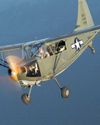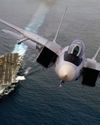STARFIRES Over Korea
Flight Journal
|July - August 2024
F-94 pilots tangle with MiGs

For the U.S. and England, the all weather interceptor business began to gain momentum in March 1948, when it became known that the Russians were producing a long-range bomber that had the capabilities of reaching targets across the Atlantic and friendly airbases in the Far East. Development of the radar-equipped jets was given top priority, and it was Northrop's F-89 Scorpion and Lockheed's F-94 Starfire that would fill that gap the soonest. Both of these aircraft carried a pilot and radar observer. Until these specialized jet interceptors were operational, the prop aircraft had to carry the responsibility.
The All Weather Squadron based closest to the Korean Peninsula was the 68th at Itazuke AB Japan.
They would be the first to receive new F-94Bs in the Far East, and in turn, they would deploy a few at a time to several South Korean airbases to stand alert at night or during periods of inclement weather.
 They were spread thin because they still had the responsibility of air defense in southern Japan, and this juggling act continued on through 1951. In midJanuary 1952, the 319th All Weather Squadron, based stateside at McChord AFB, was ordered to load up and head for Korea. They would assume full responsibility for the defense of all air bases in South Korea during the hours of darkness.
They were spread thin because they still had the responsibility of air defense in southern Japan, and this juggling act continued on through 1951. In midJanuary 1952, the 319th All Weather Squadron, based stateside at McChord AFB, was ordered to load up and head for Korea. They would assume full responsibility for the defense of all air bases in South Korea during the hours of darkness.Dit verhaal komt uit de July - August 2024-editie van Flight Journal.
Abonneer u op Magzter GOLD voor toegang tot duizenden zorgvuldig samengestelde premiumverhalen en meer dan 9000 tijdschriften en kranten.
Bent u al abonnee? Aanmelden
MEER VERHALEN VAN Flight Journal

Flight Journal
ELLIPTICAL ELEGANCE
Flying and evaluating the Seafire Mark III
4 mins
November - December 2025

Flight Journal
IRON DOG
Fighting the Pacific and the P-39 at the same time
14 mins
November - December 2025

Flight Journal
Fighter Pilots: A Warrior Clan
TAKE A HARD LOOK at the two young men in these photos. Do they look as if they were bent on killing one another? On the left we have a young, unknown enlisted Japanese pilot standing in front of a Nakajima Ki-27 \"Nate,\" one of Japan's earliest monoplanes that led to the much vaunted Zero.
3 mins
November - December 2025

Flight Journal
KEN WALSH THE FIRST CORSAIR ACE
Medal of Honor pilot's combat adventures
12 mins
November - December 2025

Flight Journal
Big Chief's Little Chief
Thunderbolt action with the Wolf Pack
11 mins
November - December 2025

Flight Journal
ENEMY PILOTS SPEAK Voices from the other side
All too often American students of air warfare forget that enemy aircraftwhether Messerschmitts or MiGs-were flown by human beings with the same motivations and traits as Allied airmen. More often than not, the only difference between friend and foe was the paint on the airplane and where they landed. Therefore, we've assembled a variety of accounts from WW II Axis fighter pilots, men who were more than simply targets.
11 mins
November - December 2025

Flight Journal
FLYING THE FW 190
A legend gets checked out in the Butcher Bird
15 mins
November - December 2025

Flight Journal
DOUBLE-THEATER ACE
The fearless missions of legendary fighter pilot Col. John D. Landers
12 mins
November - December 2025

Flight Journal
WARBUG IN THE PACIFIC
Surviving combat in a Stinson OY-1/L-5
10 mins
September - October 2025

Flight Journal
WINGS OF THE FLEET
Celebrating the U.S. Navy's 250-year legacy
9 mins
September - October 2025
Listen
Translate
Change font size

